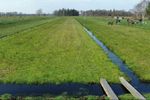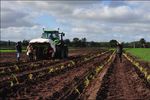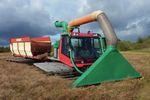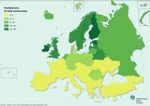PEATLANDS IN THE EU COMMON AGRICULTURE POLICY (CAP) AFTER 2020 - International Mire ...
←
→
Page content transcription
If your browser does not render page correctly, please read the page content below
PEATLANDS IN THE EU
COMMON AGRICULTURE POLICY (CAP) AFTER 2020
Position Paper - (Version 4.8)
KEY TARGET
To facilitate the new environmental ambitions of the Post-
2020 Common Agricultural Policy (CAP) and to create coher-
ence between agricultural and climate policies, CAP must
safeguard and stimulate the preservation of carbon-rich
soils through protection of peatlands1.
PRIMARY GOALS
1 Guaranteed eligibility of farmed wet peatlands for CAP
payments.
2 Phasing out CAP payments for drained peatlands.
3
Establishment of results-based agricultural payment Figure 2: Drained and degraded peatlands emit up to 30 tonnes of CO2
schemes remunerating ecosystem service provision as per hectare per year. (Photo: Ireland, courtesy of Care Peat EU Interreg
low greenhouse gas emissions from peatlands. project)
PEATLAND UTILISATION: AN INTERPLAY OF PEATLANDS AND ORGANIC SOILS IN THE
AGRICULTURAL AND CLIMATE POLICIES EUROPEAN UNION
Peat forming lands are particularly rich in organic matter. Peat Peatlands occur in almost all EU Member States, with a con-
accumulates in areas where the decomposition of plants centration in north-western, Nordic and eastern European
is slowed due to wet conditions, which results in a large countries2 (see figure 3).
store of carbon accumulated over thousands of years. Globally the EU is the second largest emitter of
Fully functional, healthy peatlands are the most space greenhouse gases (GHG) from drained peatlands (220 Mt
efficient long-term carbon store and sink in our planet’s CO2eq/year = 15% of total global peatland emissions3). This
biosphere (see figures 7 & 8). Peatlands have been drained is equivalent to circa 5% of the official EU greenhouse gas
for agriculture, forestry and peat extraction. emissions total of 4,483 Mt CO2eq/year in 20174. Peatland
The negative consequences of this use is becoming increas- emissions are reported by EU countries in the National
ingly obvious (see figures 1 & 2). Drainage allows oxygen Inventory Submissions to UNFCCC but not yet accounted16.
to enter the soil, leading to microbial decomposition of the The largest peatland emitters in the EU are Germany,
peat and thereby breakdown of the stored carbon leading Finland, United Kingdom, Poland, Ireland, Romania,
to emission of substantial amounts of CO2 and N2O. Further Sweden, Latvia, Lithuania, and the Netherlands. In most of
negative consequences of drainage are a reduction in water these countries, drained peatlands contribute to more than
quality through the discharge of nutrients to ground and sur- 25 % of total emissions from agriculture and agricultural
face water and land subsidence (1-2 cm yearly). This results in land use (see figure 4)
increasing drainage costs, higher flooding risks, reduced
9% of EU peatland emissions are caused by 16 of the 28
9
water quality and - ultimately - loss of productive land.
EU Member States.
Figure 1: Drainage-based agriculture such as dairy farming on peat-
lands is widespread across the EU. It is subsidised by CAP payments but
causing huge environmental losses and damage. (Photo: Denmark, by
Hans Joosten). Figure 3: Map showing peatland distribution across Europe indicating
proportions of peatlands of the total country area.5THE SOLUTION
These emissions can be significantly reduced by raising
water levels near to the surface (e.g. by drain blocking, stop
pumping in polders), which reduces emissions and protects
the remaining peat carbon store. Afforestation on drained
peatlands is an inappropriate mitigation measure and can
result in increased carbon emissions.
In the long term, a complete cessation of peatland drainage
and reversal of the effects of existing drainage is unavoidable
if we want to reach the core goal of the Paris Agreement -
zero net emissions by 2050. The EU and all its Member States
have unanimously affirmed this goal.
However, healthy peatlands are not consistent with
conventional agricultural land use. If we want to continue
productive land use on peatlands, a paradigm shift is re-
quired involving new concepts, crops and techniques as well
as adjustments of the current agricultural policy framework.
Appropriate climate policy measures, especially in the frame
of the Common Agricultural Policy (CAP), must enable land
use (sectors Agriculture and LULUCF) to minimize peatland
emissions. The European Commission (2017) has declared
environmental protection and the fight against climate
change as the greatest challenge of the future CAP. This pol-
icy brief demonstrates how wisely adjusted peatland man-
agement can achieve low-emission goals with further bene-
fits for farmers, the economy, society and the environment.
PALUDICULTURE AS A LOW-EMISSION LAND USE
Figure 4: Map showing total greenhouse gas emissions from agricul- ALTERNATIVE FOR PEATLANDS
ture on peatlands in the EU Member States [6]
Paludiculture is defined as productive land use of wet peat-
lands that stops subsidence and minimises emissions7.
Rewetting just X% of agricultural land will save up to
In contrast to drainage-based agriculture, paludiculture cul-
Y% of agricultural greenhouse gas emissions
tivates crops that are adapted to high water levels, such as
reed, cattail, black alder and peat mosses. It can have a higher
value both financially and ecologically. Using a variety of es-
tablished techniques, the products of paludiculture can be
processed to use as insulation and construction materials,
growing media and bio-refinery products as well as for live-
stock fodder and for fuel. Innovative products, including, cos-
metics, medicinal and food products, are under development.
Large-scale implementation of paludiculture, however,
requires agricultural policies to set explicit incentives that
ensure that it becomes advantageous for landowners to
rewet drained agricultural peatlands and subsequently to
maintain them as wetlands (see figure 5).
Implementation of carbon farming8 on peatlands by
introducing specific payments for keeping carbon in the
ground. This could be granted via public payment or appro-
priate credit schemes9 for farmers who wish to avail of carbon
credits through the voluntary carbon market at regional and
national levels. These schemes can be supported and recog-
nised by the CAP and governments in the Member States.
Facilitating results based agricultural payments
schemes (RBAPS)10 specifically for peatlands to ensure
that wet peatlands can be maintained to a high standard.
Landowners should not lose out by actively maintaining wet
peatlands, so that greenhouse gases are reduced or peat-
lands can act as net carbon sinks. A time and cost-effective
monitoring system of GHG emissions on parcel level across
Figure 5: Percentage of agricultural land that needs to be rewetted different land uses and management regimes has to be
(inner circle: EU-3%) in order to reduce agricultural greenhouse gas
developed and implemented to allow for sound MRV (meas-
emissions (outer circle: EU-25%) [6]
uring, reporting, and verification).RECOMMENDATIONS
The CAP framework is generally suitable for realising an EU-
wide realignment of peatland maintenance and supplying
(co-)funding for reaching the stated goals. Additional sup-
port may come from the European Regional Development
Fund (ERDF) (cf. funding directives in Bavaria11 and Lower
Saxony12, Brandenburg13, Germany). A combination of the
following actions can pave the way towards low-emission
peatland utilisation 14:
✸ Guaranteeing eligibility of farmed wet peatlands for
1st and 2nd CAP pillar payments;
✸ Phasing-out CAP funding for drained peatlands
(direct payments, agri-environment-climate schemes,
investment promotion for drainage systems etc.) in order
to create coherence between agricultural and climate
policies and to underline the necessary paradigm shift
for reaching the climate change mitigation goals under
international law;
✸ Remunerating ecosystem services with results-based
agricultural payment schemes to set attractive incen-
tives for reducing GHG emissions and for supplying other
ecosystem services (e.g. nutrient retention, water quality
and flood regulation);
✸ Implementing national peatland carbon credit
schemes in the 16 EU Member States with significant
peatland emissions, to facilitate carbon retention and
carbon capture;
✸E
stablishing long-term programmes (15-20 years)15
to ensure planning security and permanence of positive
climate and environmental effects;
✸ Applying and refining existing instruments (e.g. EAFRD,
ERDF) to provide incentives for all implementation steps,
including site preparation, establishment of suitable
crops and techniques, raising the water level, selection
and breeding, management and harvest with adapted
agricultural equipment, processing and marketing;
✸ Promoting knowledge transfer, financial and infra-
structural support, consultation and establishment of
demonstration farms;
✸ Exchanging on experience between peatland-rich
regions in Europe to develop regionally customised
solutions, including participation and acceptance of all
stakeholders, output orientation and cost-efficiency.
Figure 6: Paludiculture includes planting of cattail for insulation
material, harvesting of sedges for energy production, grazing with
water buffaloes for food, sphagnum farming for horticultural sub-
strate and many other types of ‘wet’ agriculture or forestry. (All pic-
tures: GMC). Figure 7: Fully functional, healthy peatlands are the most space
efficient long-term carbon store and sink in our planet’s biosphere.PALUDICULTURE AND CARBON FARMING PRINCIPLES
AS WIN-WIN-OPTIONS ✸ Landowners within the EU to be encouraged to maintain
Paludiculture and carbon farming, supported by existing and re-establish high water levels in peatlands to maxim-
and adapted agricultural policy measures, will provide win- ise carbon storage and minimise greenhouse gas emis-
win-options for various sectors of society (see figure 6): sions. No landowner in the EU should be economically or
socially disadvantaged by maintaining or developing wet
✸ Agriculture: New income opportunities on marginal
peatlands or rewetting peatlands.
organic soils, soil protection, better social image, climate
adaptation (reduction of risks of crop failures after heavy ✸ Deliberate degradation of the long-term carbon storage
rains, floods or droughts); capacity of peatlands should always be penalised and
should never result in increased payments from the EU.
✸ Society: Securing and creating employment in rural
areas, regional recreation and tourism, identity, reduction
of economic collateral damage caused by drainage;
✸ Economy: Substitution of fossil resources (energy sources,
mineral oil-based construction material, peat in horticul-
ture) by renewable biomass materials from wet peatlands,
bio-economy, sustainable food and fodder production;
✸ Environment: Climate, water and biodiversity protection
with comparatively low costs, support of wide-ranging
ecosystem services. Figure 8: Sphagnum moss is the dominant vegetation of most
peatlands.
CONTACT DETAILS:
Greifswald Mire Centre National University of Ireland, Galway Wetlands International European Association
Ellernholzstr. 1/3 Data Science Institute Rue de Trèves 59-61
D-17489 Greifswald, Germany Galway, Ireland B-1040 Brussels, Belgium
www.greifswaldmoor.de www.nuigalway.ie www.wetlands.org/europe
info@greifswaldmoor.de niall.obrolchain@insight-centre.org post@wetlands.org
@greifswaldmoor @nuigalway @DSIatNUIG
REFERENCES
[1] EU Budget: The CAP after 2020 https://ec.europa.eu/commission/sites/beta-political/files/budget-may2018-modernising-cap_en.pdf
[2] Tanneberger et al. (2017) The Peatland Map of Europe http://mires-and-peat.net/media/map19/map_19_22.pdf
[3] Joosten (2009) The Global Peatland CO2 Picture https://unfccc.int/sites/default/files/draftpeatlandco2report.pdf
[4] Eurostat Greenhouse gas emission statistics https://ec.europa.eu/eurostat/statistics-explained/pdfscache/1180.pdf
[5] Joosten et al. (Hg.) (2017): Mires and peatlands of Europe. Status, distribution and conservation. Stuttgart: Schweizerbart.
[6] Data compiled by Greifswald Mire Centre based on National Inventory Reports 2019. (Sectors Agriculture, LULUCF - Cropland and Grassland)
[7] Wichtmann et al. (2016) Paludiculture-productive use of wet peatlands. https://www.schweizerbart.de/publications/detail/isbn/9783510652839
[8] EC Carbon Farming Schemes in Europe – Roundtable https://www.ecologic.eu/sites/files/presentation/2019/cf_roundtable_background_04102019_final.pdf
[9] MoorFutures – how regional carbon credits from peatland rewetting can help nature conservation in protected areas
https://www.iucn.org/content/moorfutures-%E2%80%93-how-regional-carbon-credits-peatland-rewetting-can-help-nature-conservation
[10] Results-based Payments for Biodiversity Guidance Handbook https://ec.europa.eu/environment/nature/rbaps/handbook/docs/rbaps-handbook.pdf
[11] http://www.stmuv.bayern.de/themen/naturschutz/foerderung/efre.htm
[12] Klimaschutz durch Moorentwicklung https://www.klimaschutz-niedersachsen.de/_Resources/Persistent/da7070a86b48a9853a1a5126d3cb77cf-
250d8add/Richtlinie%20Klimaschutz%20durch%20Moorentwicklung.pdf
[13] Moorschutzrichtlinie ProMoor https://lfu.brandenburg.de/cms/detail.php/bb1.c.427149.de
[14] Wichmann (2018) Economic incentives for climate smart agriculture on peatlands in the EU.
https://greifswaldmoor.de/files/dokumente/GMC%20Schriften/Report_Economic%20incentives_Cinderella_GMC%20Proceedings_web.pdf
[15] Integrated Carbon Observation System (ICOS) https://www.icos-ri.eu
[16] Reporting GHG emissions from organic soils in the EU
https://greifswaldmoor.de/files/dokumente/GMC%20Schriften/18-02_Barthelmes_GMC.pdf
SUPPORTED BY:
*
* This publication was produced with the assistance of the Life Programme of the European Union, although the views expressed can in no way be taken to be the views of the donor.You can also read



























































